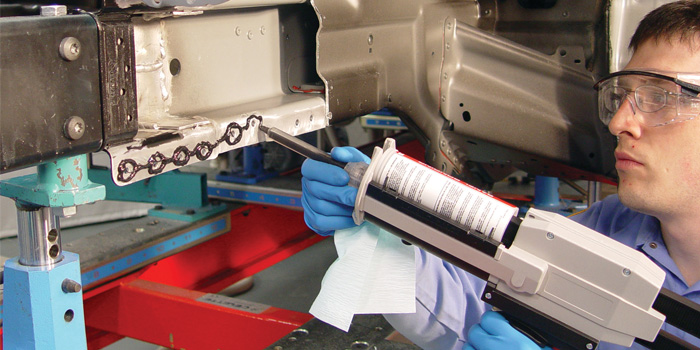“What are the differences between regular metal adhesives and those being offered for aluminum repairs? Also, why is the cost of these materials so much higher?” – Bob Adamek, president, Bodies by Bob Inc., Clinton Township, Mich.
When this question was first given to me, I thought I knew the answer. I was wrong. My research has reminded me that making assumptions can be dangerous.
Galvanic Corrosion
First, even though both steel and aluminum are in the metal family, they have some similarities and differences. Like all metals, there are conditions or elements that are destructive to their mechanical properties.
Both metals oxidize but have different reactions to this oxidization process. They’re considered dissimilar metals on the reactive chart. Galvanic corrosion is an electrochemical process in which one metal corrodes preferentially to another when both metals are in electrical contact, in the presence of an electrolyte. We can visualize this as we’ve all seen pictures of this happening. A piece of steel is joined to an aluminum piece. The aluminum oxidizes and white powder emerges quickly while the steel shows scaling rust. An important part to remember is it takes an electrolyte to allow ions to pass between the two metals, causing the galvanic corrosion.
Products
So how does this relate to adhesives being used in automotive manufacturing and repair? The adhesives in question are a mixture of chemicals and minerals, and some of these combinations may include products that could have a negative effect on the surface of the metal bonding. A primer may sometimes be used to promote adhesion and insulate against the corrosion process.
Some products in the automotive industry are bare metal products in that they apply right to the bare metal with no primers. Some of these products are black in color, which comes primarily from carbon being used in production. Carbon on bare steel is not an issue. Carbon on aluminum is an issue as these are considered two dissimilar products. The carbon properties may react with the aluminum, causing corrosion between the adhesive and aluminum.
Carbon is a relatively easy and inexpensive product to use in manufacturing. It’s not just adhesives that have carbon but moldings, gaskets, clips and about anything plastic. Even in a gasket, this carbon could react with bare aluminum. This is why epoxy priming and painting to separate is so critical on aluminum parts where anything comes in contact and moisture or any other chemical or substance is used that allows ions to pass between. Even windshield adhesives provide a non-conductive product for aluminum vehicles. It’s still black in color but uses a different product than carbon or a very limited amount.
Any time a company removes the carbon from a product, the price often goes up. This happens not just because it’s more expensive to manufacture without the carbon but also because there’s lower demand and development costs for a limited-use product. As products become more needed and supplies increase, mass manufacturing becomes cheaper.
What I’ve Learned
Now you’ve heard a standard response I’ve been using for years. Not being an engineer or chemist, I receive my training and information from many manufacturers. Scientists and engineers use a lot of big words and explanations that go beyond my college education. The problem with my response above is twofold. I’ve learned that 1) assumptions can be wrong, and 2) there have been many advancements in products.
The first is to assume all black products have carbon. Not true. Some are carbonless or low content, such as some dealer or OEM clips. The cheaper clips used for replacements at shops may have carbon, but the factory parts may not. That’s a problem as you, the technician, can’t tell the difference. Therefore, epoxy priming and painting become a necessity to prevent the electrochemical process.
The other is that some adhesives that are recommended have carbon. The carbon is actually a suspended component. In laymen’s terms, it’s non-reactive as the chemicals it’s produced with do not permit electrochemical reaction. The ions can’t react as no electrolyte is present. But the confusion lies with comparing the above statement with what a vehicle manufacturer states or recommends. Companies that produce their products manufacture and test for compliance. The vehicle manufacturer may recommend a product based on assumption or caution. You, as a business, would need to make a decision as to whether to follow that recommendation or to trust the company whose products you buy. Talk with the reps from your companies. If the product can serve a dual role well, then maybe the KIS approach is best: Keep It Simple.
Never assume all products or procedures are the same. There’s always exceptions. Read the directions for proper use. This is truly just a basic explanation to a very complex issue. I hope it clears up some confusion.














